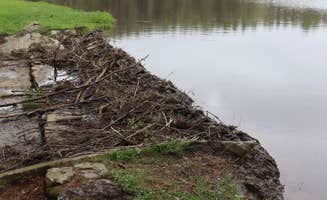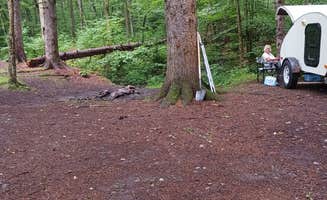Dispersed camping near Hunt, New York occurs primarily across multiple state forests with primitive facilities. Terrain in this western New York region features rolling hills with mixed hardwood forests and scattered ponds at elevations between 1,500-2,000 feet. Weather conditions vary dramatically by season, with summer temperatures averaging 70-85°F and winter often bringing heavy snowfall that limits access.
What to do
Wildlife observation: Palmers Pond State Forest attracts diverse wildlife including beaver colonies. "Lots of beavers to watch throughout the day," notes camper Matt M., making it ideal for nature photography and quiet observation.
Fishing opportunities: Several state forest ponds offer fishing without crowds. At Camp Seneca, Kevin C. recommends camping "next to the creek" where fishing spots are easily accessible from designated sites.
Hiking access: The Finger Lakes Trail passes through several forests including Boyce State Forest. "If you walk/hike 1/2 mile you will find a lean-to with fire pit and privy," mentions Alan C., making it suitable for overnight backpacking trips.
What campers like
Solitude and space: Many campers appreciate the absence of crowds. At Palmers Pond State Forest, Mitch P. reports, "I drove out from Wisconsin and was the only one there. Threw up the tentsile tent over looking the pond on the south side."
Flat terrain for setup: Finding level ground for tents isn't difficult at certain sites. Camper Matt M. mentions Palmers Pond has "abundant flat and grassy terrain under pines near a beautiful lake."
Natural surroundings: The undeveloped setting appeals to those seeking rustic experiences. "The site was very nice. Clean and well maintained. I was able to set up next to the water with no problem," writes Marjoe M. about their May visit to Palmers Pond.
What you should know
Access challenges: Road conditions and navigation problems occur frequently. For Ossian State Forest, Daniel R. warns, "The roads are a little rough also," and another reviewer notes areas "blocked off due to fallen trees."
Variable site conditions: Site maintenance levels differ dramatically between areas and seasons. "Obvious that the area has not been tended to in some time. Only a couple of the primitive sites are accessible and most of the trails are choked with growth," reports Daniel R. about Ossian State Forest.
Specific navigation advice: Several forest access points require local knowledge. For Palmers Pond, Sydney M. advises, "Do not take Palmers pond road. When you get off of Interstate 86 you will want to take turnpike rd to south road. There are not any lights to show the sign so it's kinda hard to find."
Tips for camping with families
Best campsites for children: Select sites with natural features that interest kids. At Camp Seneca, Kevin C. recommends sites "next to the creek" that offer natural play opportunities while remaining within sight of the campsite.
Seasonal considerations: Timing your visit affects conditions significantly. Caitlyn R. found Palmers Pond State Forest accommodating in summer: "The road was gravel but pretty easy to drive. I found one of the first spots and was very comfortable."
Bathroom facilities: Only select sites offer toilets. Boyce State Forest provides what Zack B. humorously calls an "air conditioned loo" at the lean-to site, while Camp Seneca offers a portable toilet that Kevin C. describes as "pretty clean" with "plenty of paper."
Tips from RVers
Site suitability: Not all dispersed sites accommodate recreational vehicles. Casaundra H. reports that Palmers Pond has "no electricity or water hook ups, very secluded," making it suitable only for self-contained RVs.
Road conditions: Approach roads can be problematic for larger vehicles. Sydney M. warns about navigation challenges at Palmer's Pond, noting "The directions took us to a dead end like the other reviews stated," which can be especially troublesome with larger rigs.
Weather impacts: Seasonal conditions affect site accessibility. Zack B. experienced wet conditions at Boyce State Forest where the "trail was more of a stream than a trail" and recommends visitors "come in dryer season or to bring rubber boots."



